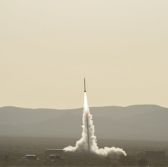 NASA has launched three space technology demonstration payloads on a UP Aerospace-built rocket as part of the agency’s Flight Opportunities program.
NASA has launched three space technology demonstration payloads on a UP Aerospace-built rocket as part of the agency’s Flight Opportunities program.
UP Aerospace’s SpaceLoft 12 suborbital launch vehicle carrying the instruments lifted off Wednesday at Spaceport America in New Mexico, NASA said Thursday.
The mission tested the deployment sequence and entry performance of the Adaptable Deployable Entry and Placement Technology system, an umbrella-like heat shield intended for sample return missions and planetary landings.
The second payload is called Suborbital Flight Environment Monitor and designed to track the acceleration, temperature and pressure in a suborbital rocket’s payload bay during flight.
The final instrument is built to measure the hardware and software performance of the Autonomous Flight Termination System in suborbital flight.
NASA’s Ames Research Center in Mountain View, Calif., developed the first two experimental payloads and its Kennedy Space Center in Florida created the last.
The Space Technology Mission Directorate funded the mission through the Flight Opportunities program, which offers an opportunity for the commercial spaceflight industry to support space missions with reusable suborbital launch vehicles, rocket powered vertical takeoff-and-landing platforms, high-altitude balloons and parabolic aircraft flights.




